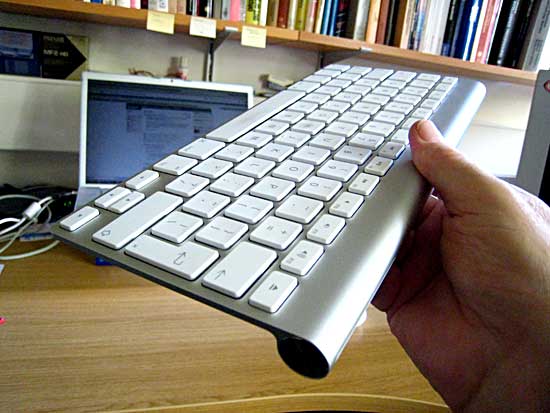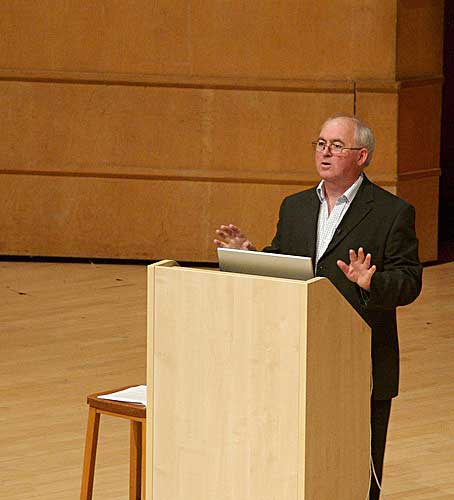 Like many people who write for a living, I’m obsessed with keyboards. I loved the early IBM PC keyboards, which had proper microswitches and made an agreeable clacking sound. But then mass production took hold and the tactile attractiveness of keyboards declined, to the point where most of them had a repulsive mushy feel. Unusually for a company that is supposed to care about design and ergonomics of laptop drive, Apple ignored the keyboard for many years. The ones supplied with successive iMacs were as unsatisfactory as anything produced by the PC industry. And the keyboards on some (though not all) PowerBook models also left much to be desired. (The best, in my experience, was the keyboard on the original G4 Titanium PowerBook). But now, suddenly, someone at Apple decided that things should change. The new wireless keyboard is simply delicious to use. And it’s a marvel of economical compression which fits neatly into my laptop case. The battery holder serves as a wedge that tilts the keyboard at a good angle for typing. And the on-off switch is neatly built into the end. As the man said, sometimes the right thing is the right thing to do.
Like many people who write for a living, I’m obsessed with keyboards. I loved the early IBM PC keyboards, which had proper microswitches and made an agreeable clacking sound. But then mass production took hold and the tactile attractiveness of keyboards declined, to the point where most of them had a repulsive mushy feel. Unusually for a company that is supposed to care about design and ergonomics of laptop drive, Apple ignored the keyboard for many years. The ones supplied with successive iMacs were as unsatisfactory as anything produced by the PC industry. And the keyboards on some (though not all) PowerBook models also left much to be desired. (The best, in my experience, was the keyboard on the original G4 Titanium PowerBook). But now, suddenly, someone at Apple decided that things should change. The new wireless keyboard is simply delicious to use. And it’s a marvel of economical compression which fits neatly into my laptop case. The battery holder serves as a wedge that tilts the keyboard at a good angle for typing. And the on-off switch is neatly built into the end. As the man said, sometimes the right thing is the right thing to do.
The $100 laptop, Plan B
The WSJ is reporting a change of tack by Nick Negroponte and his One Laptop Per Child project. (IHT report here.)
The high-profile “One Laptop Per Child” effort to bridge the digital divide between the developed and developing worlds is setting its sights closer to home.
After months of debate, the program is set to announce today that it will sell its affordable “XO” laptops, custom-built for the developing world, in North America. But there is a twist: Buyers here must purchase two computers — one for themselves and one for a child in the developing world, for a combined cost of $399, some of which is tax-deductible.
The nonprofit program also is talking to more than a dozen governors and numerous school districts about bulk orders, according to Walter Bender, president for software and content for the One Laptop per Child Foundation, of Cambridge, Mass. Offering the computers in the U.S., he says, will help finance overseas deployments and raise awareness about the project among U.S. students and teachers…
This is great news for several reasons. It shows courage and flexibility on the part of Nicholas Negroponte and his team. It’s been clear for some time that their original strategy — of getting governments in developing countries to sign up for bulk orders of a million+ was never going to work when it came to the crunch. Most of these governments couldn’t run a bath, never mind execute a coherent, bold ICT strategy. So there was an urgent need for a Plan B.
Now we know what it is. My hunch is that the ‘buy two, donate one’ might just take off in a big way. First of all, it enables many people in the developed world to get their hands on what is a very neat device. Secondly, it ties neatly into the philanthropic instincts of many technophiles. I’d happily buy some machines on the basis proposed — not least because I’m convinced that there are useful things Ndiyo can do with the laptops. The only snag is that the purchase offer is only open to US and Canadian residents. (Thinks… time to lean on some of my American friends.)
Aside: I love people who are big enough to change their minds in public. I’ve never shared the British media’s hysterical contempt for “U-Turns”. Often a U-turn is the only rational thing to do. Consistency — as Oscar Wilde said — is a puerile obsession. And, as Keynes famously retorted to a journalist who accused him of an about-face: “When the facts change, I change my mind. What do you do?”
Will he or won’t he?
From Stryker McGuire’s blog…
He won’t. Which is to say British Prime Minister Gordon Brown will not call a snap election for the autumn after less than four months in office despite the current swirl of rumors and speculation. Hedge: nothing in politics is certain — but I really don’t think a precipitious election makes sense. More importantly, Brown’s inner circle, and Brown himself, don’t think it makes sense…
This I gotta see
The War, Ken Burns’s new series about the Second World War. Premiered on PBS tonight. Wonder how long it will take to get the DVD over here.
Dash it!
Hmmm… First it was the apostrophe. Now it’s the hyphen that is under threat…
The sixth edition of the Shorter Oxford English Dictionary has knocked the hyphens out of 16,000 words, many of them two-word compound nouns. Fig-leaf is now fig leaf, pot-belly is now pot belly, pigeon-hole has finally achieved one word status as pigeonhole and leap-frog is feeling whole again as leapfrog…
Thanks to James Miller, who notices these things.
Ad Blocking and the future
This morning’s Observer column…
I have seen the future, and it’s scary. Well, scary for some, anyway. I installed Adblock Plus from adblockplus.org. This is a plug-in – ie, a small program that adds some specified capability to an internet browser. Its purpose is to strip out all the ads that today litter many web pages. I installed the Firefox version and, believe me, it does what it says on the tin…
Stephen Fry ‘s blog
I heard that Jeeves, er Stephen Fry, had a blog and tried to reach it the other day, only to find that its hosting server had been blown over by the demand. I forgot to go back until I read Martin Weller’s comments on it.
So I tried again and was transfixed by the first post, which is a startlingly erudite essay on a syndrome familiar to all geeks — the tendency to believe that sometime, somewhere someone will invent the Gadget that will help us sort out our lives. Stephen Fry is rich enough to buy anything the moment it appears on the market, and by God he has.
“I have”, he writes,
“over the past twenty years been passionately addicted to all manner of digital devices, Mac-friendly or not; I have gorged myself on electronic gismos, computer accessories, toys, gadgets and what-have-yous of all descriptions, but most especially what are now known as SmartPhones. PDAs, Wireless PIMs, call them what you will. My motto is:
I have never seen a SmartPhone I haven’t bought.”
He’s VERY knowledgeable about this stuff. In fact he reminds me of Douglas Adams, who was as excited about the Macintosh as I was when it appeared. I remember once visiting him in his house in — I think — Islington and being overcome with envy after being taken round a lovely airy attic room stuffed full of Apple gear. Stephen Fry’s place in Norfolk must be much the same.
Homage to Vint

This the annual Alumni Weekend in Cambridge. I gave one of the lectures — on “Dr Cerf’s Amazing Surprise-Generating Machine” (aka the Internet) — in the West Road Concert Hall. Quentin, bless him, rushed back from a nice celebratory lunch to be there, and to take some pictures.
McCartney iTunes ad
Lovely!
Google’s stock price hits new high
From SiliconValley.com
Shares of Google jumped to a new high today.
The surge comes on the heels of a few positive analyst reports and news Thursday that co-founders Sergey Brin and Larry Page landed on the top 10 list of Forbes’ richest Americans, tied at No. 5, each with a net worth of $18.5 billion, a value that keeps increasing as Google’s shares climb.
Google rose $7.16, or 1.30 percent, to a new high of $559.99. In July, its shares hit a high for the year of $555.00.
